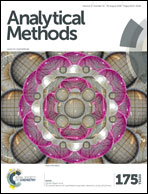Study of azo-coupling derivatization by sequential injection coupled with spectrophotometric optical fibre detection for propofol analysis
Abstract
In this work, azo-coupling derivatization was performed for propofol analysis. The derivatization produced a red shift in the maximum absorbance of propofol, thus preventing signal interference from endogenous substances in plasma. An automated method was developed for the detection of propofol based on the reaction of propofol with a diazonium salt via sequential injection (SI). The resulting coloured product had an absorbance maximum at 483 nm. The method was compared to a traditional spectrophotometric method performed manually. Both methods provided comparable validation parameters, with linear working ranges of 3–18 μg mL−1 and 6–21 μg mL−1 of propofol in plasma (R = 0.998, 0.996); recoveries of 89.3–99.6% and 102–104% and RSDs of 4.25–5.58% and 4.08–5.52% were obtained at three different concentrations for the SI-spectrophotometric and spectrophotometric methods, respectively. A sample throughput of approximately 46 injections per h was achieved for the SI-spectrophotometric method. This automated method provides a foundation for the rapid measurement of propofol in plasma samples.


 Please wait while we load your content...
Please wait while we load your content...